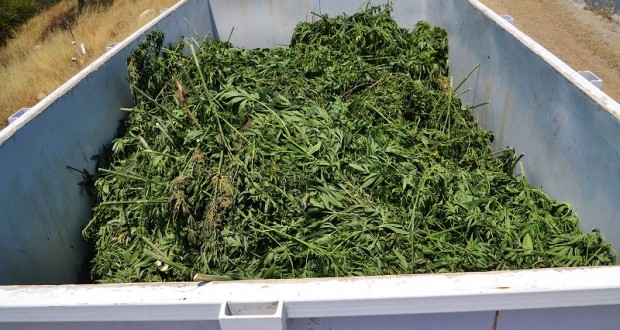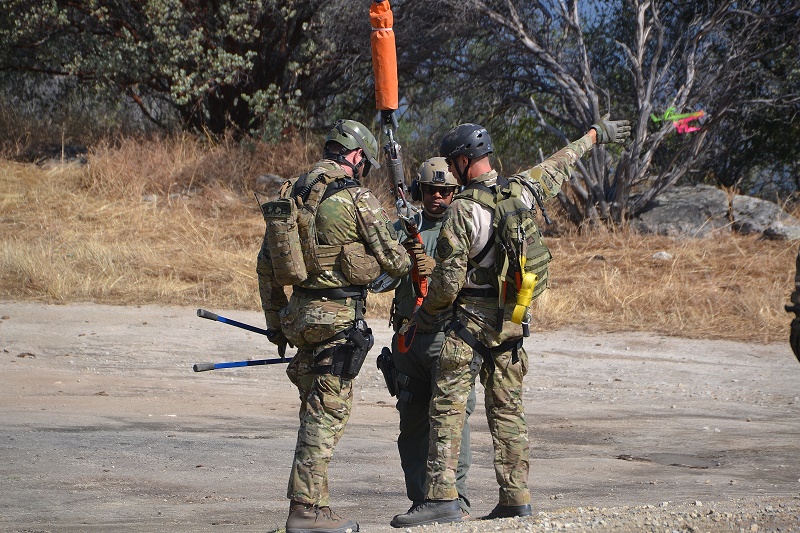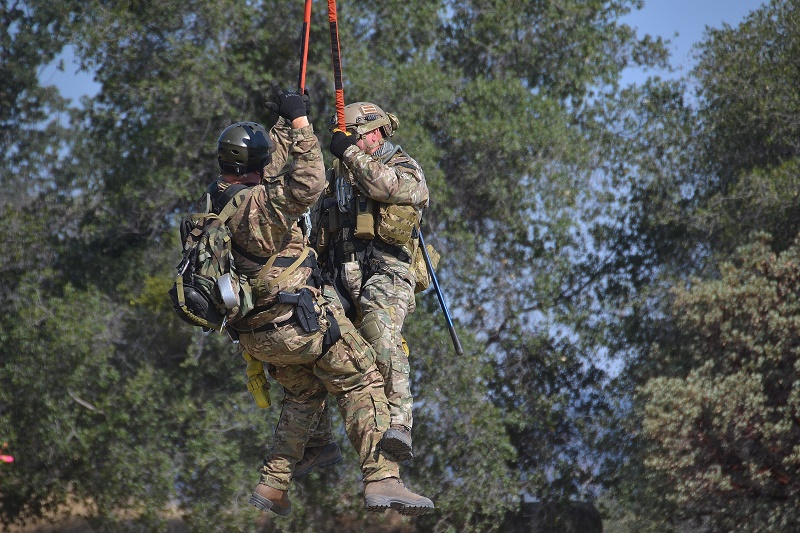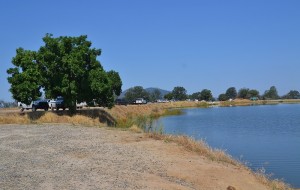 NORTH FORK — Law enforcement officials have just completed three days of marijuana eradication operations in the North Fork area, destroying over 73,000 plants being grown, for the most part, on public lands.
NORTH FORK — Law enforcement officials have just completed three days of marijuana eradication operations in the North Fork area, destroying over 73,000 plants being grown, for the most part, on public lands.
A joint effort between the Madera County Sheriff’s Office, the U.S. Forest Service, Fish and Wildlife, BLM and the California National Guard started on Monday, wrapping up today as huge quantities of marijuana hauled off to the landfill and mixed in with tons of sludge under the supervision of law enforcement.
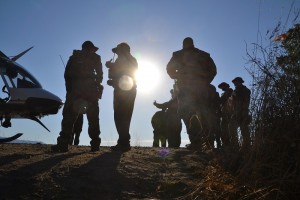 At 7 a.m. on Monday, 22 deputies and agents staged at Corrine Lake south of North Fork, supported by one helicopter and crew, and Sierra National Forest Engine 51 which was on site as fire protection to mitigate the danger of helicopter fuel at the scene. Firefighters also set a pump in the lake and kept the landing zone watered down.
At 7 a.m. on Monday, 22 deputies and agents staged at Corrine Lake south of North Fork, supported by one helicopter and crew, and Sierra National Forest Engine 51 which was on site as fire protection to mitigate the danger of helicopter fuel at the scene. Firefighters also set a pump in the lake and kept the landing zone watered down.
Six separate locations had been identified as having large, illegal grows, including one near Corrine Lake where officers removed over 45,000 plants during a 12-hour operation on Monday.
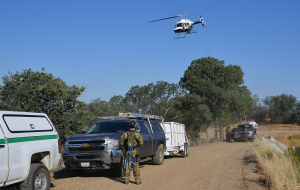 Tuesday’s operations were conducted in the Wyle Ranch area and on Cougar Drive — both south of Road 200 near Bass Fork Minit Market — and along Indian Creek southeast of North Fork. Over 21,000 plants were eradicated on Tuesday, and on Wednesday, nearly 7,000 plants were removed in the Source Point area and along Saginaw Creek.
Tuesday’s operations were conducted in the Wyle Ranch area and on Cougar Drive — both south of Road 200 near Bass Fork Minit Market — and along Indian Creek southeast of North Fork. Over 21,000 plants were eradicated on Tuesday, and on Wednesday, nearly 7,000 plants were removed in the Source Point area and along Saginaw Creek.
Tuesday’s mission began just after 7 a.m. with a safety and incident briefing. The helicopter then flew a recon mission with a case agent and spotter on board to assess the situation on the ground at each of the grows, and determine if anyone was present at the sites. They also scouted out routes that may provide access by truck, ATV or by hiking in.
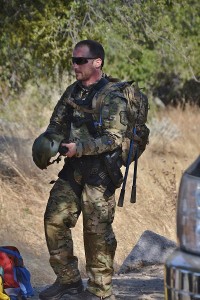 They also looked for nearby locations where they might set the helicopter down, weighing the risks of heat exhaustion or other injuries to the 11 teams.
They also looked for nearby locations where they might set the helicopter down, weighing the risks of heat exhaustion or other injuries to the 11 teams.
An important part of the operation — carried out in 100+ degree temperatures — was the presence of three medics, two from the Sheriff’s Office and one from the California National Guard. With officers clad from helmet to boots in heavy gear and packing all necessary equipment, the heat was a major factor in the day’s work.
After the initial assessment, it was determined that they would use what is called a short haul — lifting pairs of officers on a long line below the helicopter and inserting them in teams at strategic locations around each grove.
Once on the ground, the first order of business was to clear the scene of any safety issues such as booby traps, and look for any people who may be present. They then documented the scene, taking photos, noting the number of plants, any make-shift habitations, watering systems, pesticides, and the ever-present trash, seemingly indigenous at these types of illegal operations.
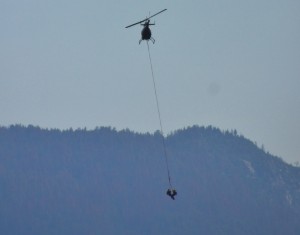 With that part of the mission accomplished, they set about eradicating the plants, either by yanking them out of the ground or chopping them off with machetes or loppers.
With that part of the mission accomplished, they set about eradicating the plants, either by yanking them out of the ground or chopping them off with machetes or loppers.
There are various ways of getting the plants out of the grove, depending on the size and quantity. On this day, much of the material was placed in large nets and air lifted back to the Corrine Lake location, where it was tossed into large trailers for the trip to the landfill. Plants that had not yet produced buds were shredded onsite.
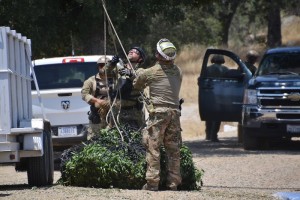 Marijuana grows on public lands have become a danger to both the public and the wildlife who inhabit the area. These lands are perfect for cartels and other illegal growers due to the vast stretches of isolated areas, many with good soil and the perfect climate for growing marijuana.
Marijuana grows on public lands have become a danger to both the public and the wildlife who inhabit the area. These lands are perfect for cartels and other illegal growers due to the vast stretches of isolated areas, many with good soil and the perfect climate for growing marijuana.
The pesticides, herbicides and fertilizers used in these large-scale operations poison wildlife and fisheries, and cause untold environment damage — and the public pays. It requires vast amounts of money and time to locate and destroy these grows, then rehab and restore the sites.
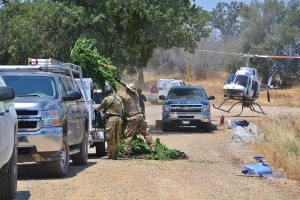 These growers cut down trees, poison animals, divert water from native plants and streams, build dams, and perhaps most disturbing — they are armed, putting an unsuspecting public in danger should anyone happen to wander into a grow site.
These growers cut down trees, poison animals, divert water from native plants and streams, build dams, and perhaps most disturbing — they are armed, putting an unsuspecting public in danger should anyone happen to wander into a grow site.
They also bring in toxic chemicals that are often illegal in the United States, including rodenticides that have been shown to be responsible for the decline of such species as the Pacific fisher.
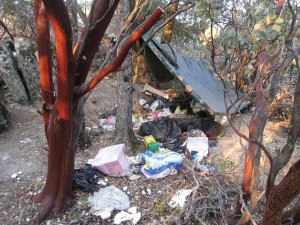 During Wednesday’s operation, officers found illegal chemicals that not only pose a danger to themselves and the public, but one spoonful would kill a bear, says Madera County Sheriff’s Commander Tyson Pogue, who was part of the 3-day operation. (trash photo from 2013 eradication operation).
During Wednesday’s operation, officers found illegal chemicals that not only pose a danger to themselves and the public, but one spoonful would kill a bear, says Madera County Sheriff’s Commander Tyson Pogue, who was part of the 3-day operation. (trash photo from 2013 eradication operation).
Cmdr. Pogue says these eradication efforts are not about whether people should be allowed to grow marijuana.
“These operations shouldn’t be viewed as much about whether or not marijuana should be legal or illegal, but more about the destruction and dangers these criminals are bringing to our public lands,” says Pogue. “They leave a wake of destruction on our public lands and pose a great risk to innocent hikers, hunters and families trying to enjoy the forest. They have no right to destroy the public land in the manner they do and it’s not fair to the families and people who may stumble into these areas by accident.”
These grows were made known to law enforcement through various ways, including overflights, reports from citizens about suspicious people or activity, or even something as simple as downslope evening breezes carrying the pungent aroma.
The people tending these grows have to be resupplied on a regular basis, so residents keeping an eye out for people who don’t belong, or loads of groceries and gardening equipment being hauled into the woods, can aid law enforcement in removing these dangers operations.
Some things to watch for when recreating on public lands:
- Cleared brush and timber in remote areas
- Signs of cultivation or soil disturbance in unlikely or remote areas
- Unusual structures in remote areas such as lean-tos or tents made from cut trees, brush, or tarps
- Large quantities of food and cooking supplies, sleeping bags, clothing, etc., indicating live-in camps
- Buckets, garden tools, various size plant pots, pesticides, fertilizer, and propane tanks
- Plastic PVC hoses, pipe, and sprinkler fittings coming from streams and makeshift water reservoirs
- Camouflage clothing or netting
- Marijuana plants (five-lobed, green leaves with serrated edges, height varies)
- Many different types of water reservoirs are built to provide water to marijuana plants. Trough-like structures, culverts covered by tarps, and PVC hoses and pipes coming from streams are common.
If you come upon something you think is a marijuana grow, you should leave immediately. Make note of any landmarks, vehicles or people in the area, and if you have a phone, mark the GPS location to help law enforcement locate the site.
Growers are often armed with all types of weapons, including assault rifles and booby traps, and a remote marijuana grow is not a place you want to hang around for very long.
(Photos by Gina Clugston)
For the stark and shocking reality of what illegal marijuana grows are doing to our public lands, watch the video below, produced by the USDA Forest Service.
https://fs.usda.gov/Internet/FSE_DOCUMENTS/stelprdb5364329.pdf

